
Established in 2017, Picosat Systems aims to deliver low-cost, low-risk technology solutions through the picosatellite PocketQube (PQ) format, which comes in one, two and three-unit sizes, with a focus on providing access to space for Earth observation (EO) and telecommunications technology verification and research missions.
Conrad Pires, co-founder and CEO of Picosat Systems, said, "We started in this area because it allows us to develop a low-cost platform, we can use picosat units for earth observation, telecommunications and a variety of other sectors as technology demonstrators, proof of concept and research missions."
Picosatellites are a class of small satellites with a mass of 100 grams to one kilogram. The form factor Picosat is using for these picosatellites is the PQ. A single unit PQ is five centimetres cubed and PQs can be built in one, two or three units’ size.
All of these are smaller than a single unit Cubesat, which is 10 centimetres cubed in size, Cubesat are classed as a nano-satellites and have a mass of one kilogram to 10 kilograms.
The recent announcement of the Australian Space Agency has provided Picosat, as with other emerging Australian space companies, the policy direction and government co-ordination lacking until now.
This means of national co-ordination and investment has also translated to a growing emphasis on developing space technology and the space industry in WA to leverage the industry, academic and scientific expertise present within the state.
"We are here looking to take advantage of the Space Agency and both the national direction and opportunities it provides for space start-ups like us," Pires explained.
Picosat has targeted key sectors within the WA economy that utilise space-based technologies like EO, telecommunications and related technologies, like the mining and resources sectors.
The company aims to address the opportunities and challenges presented by these industries with the planned development of larger small satellite platforms (e.g. nano- and micro-), including a focus on intelligent satellite systems like swarming and AI, as well as space situational awareness.
Pires expanded on this, saying, "We are looking to partner with the mining and resources sector here in Western Australia, who are heavy users of Earth observation assets to support resource development and address the challenges mining and resources companies may face when dealing with space systems or technology."
Before broad market saturation, the company plans to verify its space and ground-based technologies and capabilities with the launch of a technology demonstrator picosatellite, OzQube-1 into low-Earth orbit (LEO).
This minimum viable product (MVP) is a one unit EO PQ that will take images of Australia and transmit them back to Earth to Picosat's low-cost ground station, with work on finalising the construction of OzQube-1 and the ground station under way.
Picosat has leveraged the growing international collaboration within the space sector to partner with the International Centre for Radio Astronomy Research
(ICRAR) in late 2017 to conduct a zero gravity (zero-g) flight, which saw a hand-held deployer containing the OzQube-1 tested in zero-g onboard a European Space Agency zero-g flight.
This focus on international collaboration has also helped develop robust relationships with West Australian universities, and broader Australian universities, to support the development of a highly-capable and sustainable Australian space industry and supporting workforce.
"Picosat has been collaborating with a number of universities, particularly here in Western Australia, to help develop the skills and research capacity Australia needs to support the development of the local space ecosystem and environment," Pires explained.
Pires reinforced the company's commitment to supporting the development of WA's own space industry and ecosystem, particularly for start-ups through the continued engagement with both the state and federal government's expert reference group and the WA government's investigation into the space industry's capability within WA.
"We are approaching space from multiple avenues, whether it is research and development, commercial partnerships with the mining and resources sector or lobbying the state and federal governments, because we're finally starting to see the space industry in Western Australia and at a national level come together and we can help inform the support services and infrastructure for other start-ups," Pires said.
Receive the latest developments and updates on Australia’s space industry direct to your inbox. Subscribe today to Space Connect here.












